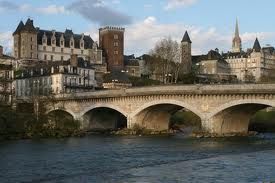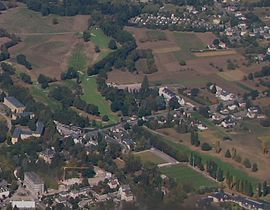(2 pm. – promoted by ek hornbeck)
The Tour de France 2012, the world’s premier cycling event kicked off last Saturday with the Prologue in Liège, Belgium and will conclude on July 22 with the traditional ride into Paris and laps up and down the Champs-Élysées. Over the next 22 days the race will take its course briefly along the Northwestern coast of France through Boulogne-sur-Mer, Abbeville and into Rouen then into the mountains of the Jura, Swiss Alps and the Pyrenees.
We will be Live Blogging Le Tour 2012 every morning at The Stars Hollow Gazette starting at 7:30 AM EDT. Come join us for a morning chat, cheer the riders and watch some of the most beautiful and historic countryside in Europe.
Pau
 Pau was the finish of Stage 15 on Monday and the riders spent the day there resting for the Stage 16 start from the same town.
Pau was the finish of Stage 15 on Monday and the riders spent the day there resting for the Stage 16 start from the same town.
In November 2011 Pau was given the title of Town of Art and History, which means it joins a national network of currently more than 170 towns on mainland France and Corsica with the same title. This prestigious honour recognises the efforts of the municipality in protecting the heritage of the city and developing its town projects. This approach of study, conservation, development and support towards architectural quality and to the quality of life has been on the go since 2009. The label Town of Art and History gives more coherance and legibility to cultural policy, to development and gives a sense of heritage to the people of Pau, whilst also reinforcing links between the residents and their town. The label is a dynamic expression of this renewed cultural policy and heritage. It is a real tool for the tourist industry and shines a light on the area, whether for Pau Porte des Pyrénées or for the surrounding towns with common themes such as holiday resorts, pyreneeism tourism or even the bearnaise identity.
Bagnères-de-Luchon
 Bagnères-de-Luchon, also referred to as Luchon, is a spa town and a commune in the Haute-Garonne department in southwestern France.
Bagnères-de-Luchon, also referred to as Luchon, is a spa town and a commune in the Haute-Garonne department in southwestern France.
Bagnères-de-Luchon is celebrated for its thermal springs. The springs, which number forty eight, vary in composition, but are chiefly impregnated with sodium sulfate, and range in temperature from 62 to 150 Fahrenheit. The discovery of numerous Roman remains attests the antiquity of the baths, which are identified with the Onesiorum Thermae of Strabo. Their revival in modern times dates from the latter half of the 18th century, and was due to Antoine Mégret d’Étigny, intendant of Auch.
Within the town today (2006), a more modern entrance to the baths sits alongside the older buildings. The bathing experience consists of repeated spells within a hot, sulphurous atmosphere in caves that run approximately 100 metres inside the Superbagnères mountain, and in a cool swimming pool within the entrance building. It was these sulphur springs that led to a twinning of the settlement with Harrogate in 1952.
Known since 1834 as “the Queen of the Pyrenees” by Vincent de Chausenque in his work Les Pyrénées ou voyages pédestres (The Pyrenees on foot), Bagneres de Luchon, which is the most characteristic mountain town in the Pyrenees, offers the perfect setting for mountain and outdoor activities but also for relaxation and fun for all. Thanks to its natural environment it makes it possible to practise many sporting activities throughout the summer and winter: hiking, mountain biking, trout fishing while canyoning, rafting and paragliding await all thrill seekers. Linked to the Superbagnères resort in eight minutes by cable car, Bagnères de Luchon does not however, rely soley on its strengths in the field of sport. In cultural terms, it offers throughout the year about six hundred events including two flagship events, the International TV Film Festival and the Flower Festival. The finishing line of the 16th stage will be located near to the Villa Julia where French writer Edmond Rostand spent twenty-two summers of his youth and wrote Les Musardies.

1 comments
Author